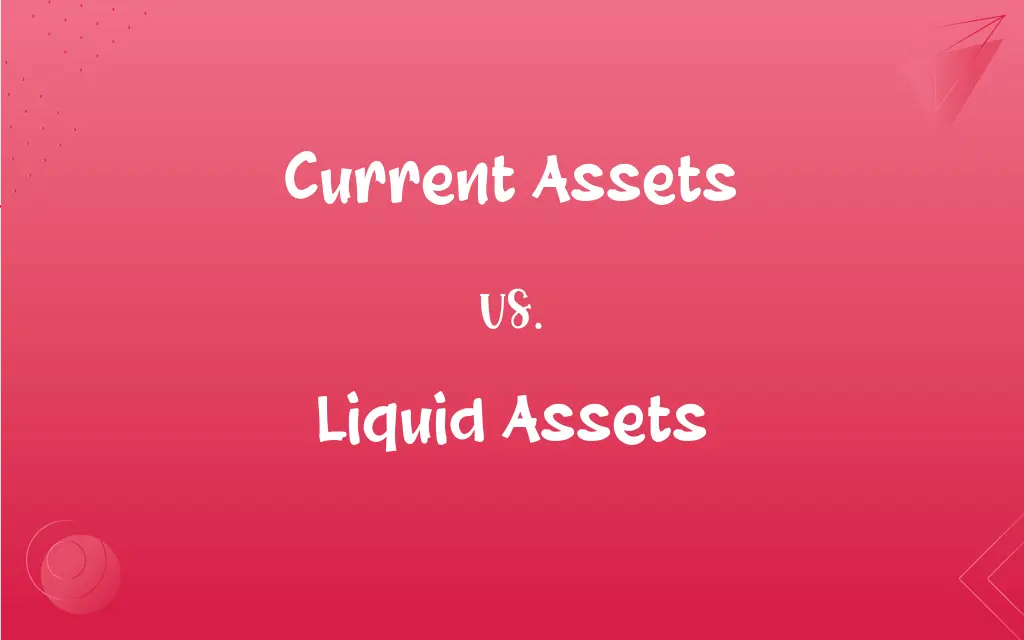Current Assets vs. Liquid Assets: What's the Difference?
Edited by Aimie Carlson || By Harlon Moss || Published on January 17, 2024
Current assets include cash, inventory, and receivables, encompassing all assets likely converted into cash within a year. Liquid assets are cash and assets quickly converted into cash without significant loss.

Key Differences
Current Assets include cash, accounts receivable, inventory, and other assets likely to be converted into cash or used up within a year. Liquid Assets are a more specific category, focusing on assets like cash and marketable securities that can be rapidly converted to cash with minimal impact on price.
Current Assets are essential for managing day-to-day operations and meeting short-term obligations. They encompass a broader range of items than Liquid Assets, which are particularly important for emergency funds or unexpected expenses due to their high liquidity.
The value of Current Assets can fluctuate more significantly, as it includes inventory and receivables, which might not convert to cash at their book value. Liquid Assets, in contrast, are valued for their stability and ease of conversion into cash.
Current Assets are a key component in calculating working capital and liquidity ratios, indicating a company's operational efficiency. Liquid Assets, while included in these calculations, emphasize the company's immediate solvency and ability to quickly generate cash.
In financial analysis, Current Assets are scrutinized for insights into a company's short-term financial health and inventory management. Liquid Assets are often examined to assess the company's ability to cover immediate liabilities without selling long-term assets.
ADVERTISEMENT
Comparison Chart
Definition
Assets expected to be converted into cash within a year
Assets that can be quickly and easily converted to cash
Composition
Includes cash, inventory, receivables, etc.
Primarily cash and marketable securities
Purpose
Support day-to-day operations and short-term obligations
Provide immediate funds for emergencies or unexpected expenses
Value Stability
Can fluctuate based on inventory and receivables
Relatively stable and less susceptible to loss in value
Role in Financial Analysis
Indicate operational efficiency and short-term financial health
Reflect immediate solvency and cash availability
ADVERTISEMENT
Current Assets and Liquid Assets Definitions
Current Assets
Assets a company expects to convert to cash within one year.
The company's current assets include its inventory, which it plans to sell within the fiscal year.
Liquid Assets
Assets that can be quickly converted to cash without significant loss.
Their liquid assets, like treasury bills, can be readily sold in case of financial emergencies.
Current Assets
Short-term economic resources of a business.
The balance sheet showed a significant increase in current assets due to improved sales.
Liquid Assets
Cash equivalent assets readily available for use.
The firm's liquid assets, including its money market accounts, offer flexibility in its financial planning.
Current Assets
Resources in a company's immediate control that can be quickly liquidated.
Her firm's current assets, like the accounts receivable, are crucial for maintaining smooth operations.
Liquid Assets
Financial resources immediately accessible and convertible into cash.
The company's liquid assets, primarily cash reserves, are available for unexpected expenditures.
Current Assets
Assets readily available for use in the ongoing operations of a business.
Current assets, including cash on hand, are vital for meeting the company's immediate expenses.
Liquid Assets
Cash or assets that can be immediately turned into cash.
He focused on increasing liquid assets to improve the company's ability to handle short-term debts.
Current Assets
Financial resources expected to bring economic benefit within a short timeframe.
Increasing current assets, such as marketable securities, is part of the company's strategy for short-term growth.
Liquid Assets
Highly liquid financial resources with minimal risk of value fluctuation.
Her portfolio's liquid assets, such as government bonds, provide a safety net for market downturns.
FAQs
What are liquid assets?
Assets that can be quickly and easily converted into cash.
How do current and liquid assets differ?
Current assets include a broader range of items; liquid assets focus on quick convertibility to cash.
What are current assets?
Assets expected to be converted into cash, sold, or consumed within a year.
Do liquid assets include accounts receivable?
Usually not, as receivables might not convert to cash immediately.
Why are current assets important for a business?
They are crucial for managing daily operations and meeting short-term financial obligations.
Can inventory be considered a liquid asset?
Typically, no. Inventory is a current asset but may not be easily convertible to cash.
How do current assets affect working capital?
They are a key component in calculating working capital, indicating short-term financial health.
Is cash classified as a current or liquid asset?
Cash is both a current and a liquid asset.
What role do liquid assets play in financial stability?
They provide immediate cash for emergencies or unexpected expenses.
Are all current assets equally liquid?
No, some, like inventory, may take longer to convert into cash.
What types of companies need more liquid assets?
Companies in volatile markets or with unpredictable cash flows often require more liquid assets.
Can a company convert all its current assets to liquid assets?
Not always, as some current assets, like long-term receivables, may not be easily liquidated.
Are marketable securities considered liquid assets?
Yes, they are highly liquid and can be quickly sold for cash.
Can a high level of liquid assets be disadvantageous?
Yes, if it indicates underinvestment in longer-term, potentially more profitable ventures.
What happens if a company has insufficient liquid assets?
It may face challenges in meeting immediate financial obligations or emergencies.
How do analysts use current assets in financial analysis?
They assess them to understand a company’s operational efficiency and inventory management.
How do liquid assets impact a company’s liquidity ratio?
They are critical in calculating liquidity ratios, showing a company's ability to cover short-term liabilities.
What is the relationship between current assets and company growth?
Adequate current assets are necessary for smooth operations, which in turn can facilitate growth.
How do liquid assets support financial planning?
They provide the flexibility to manage unforeseen expenses and investment opportunities.
Why is it important to differentiate between these two asset types?
Understanding the distinction helps in assessing a company's operational efficiency and immediate financial readiness.
About Author
Written by
Harlon MossHarlon is a seasoned quality moderator and accomplished content writer for Difference Wiki. An alumnus of the prestigious University of California, he earned his degree in Computer Science. Leveraging his academic background, Harlon brings a meticulous and informed perspective to his work, ensuring content accuracy and excellence.
Edited by
Aimie CarlsonAimie Carlson, holding a master's degree in English literature, is a fervent English language enthusiast. She lends her writing talents to Difference Wiki, a prominent website that specializes in comparisons, offering readers insightful analyses that both captivate and inform.







































































